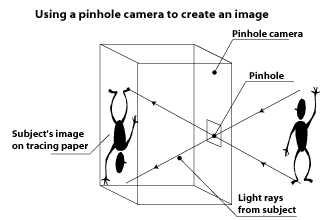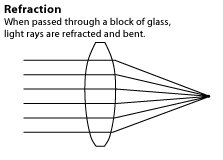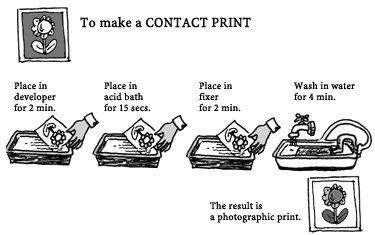|
ANSEL ADAMS LESSON PLANS SCIENCE |
|
NOTE: The chemistry activity
at the end of this section is teacher-led only.
PhysicsHow does the simplest camera work? The word "camera" means room in Italian. It was in a dark room (camera obscura) in Italy many centuries ago that it was noticed that light from outside passing through a small hole exactly reproduced the scene outside on the opposite wall. It was astonishing. And also perplexing, because the image was upside down. Why was the image upside down? Light travels in straight lines. Light rays from the top part of the scene outdoors can only reach the bottom part of the receiving area (the opposite wall) through the tiny hole, and vice-versa. The image is dim and ill-defined because the light rays travelling from each point of the subject are slightly dispersed as they pass through the hole. ACTIVITYFind out how to make a pinhole camera in My First Photography Book by Dave King. New York: Dorling Kindersley, 1994.
How can the image be made sharper? To produce a brighter and sharper image than is possible from a simple pin hole, it is necessary to converge the light rays and focus the image. This requires a lens. Study a prism to see how light is refracted or bent when it passes through.
How is this knowledge used today? The phenomena of the camera obscura (dark room) was put to use to help Italian Renaissance and Dutch artists make very realistic, "photographic" images, and later led to the development of the modern camera. SCIENCE - Chemistry How is chemistry used in photography today?
Today photographers use special paper that is coated with chemicals that
are sensitive to light. In a dark room, they project light through a negative
which is placed in an enlarger.
Can I make photographs without a negative and an enlarger? (Teachers - please call for specific chemicals and times) PHOTOGRAPHY WITHOUT A CAMERA OR FILM NEGATIVE Set up the room as above.
Now you have the final image - a negative of the image you started with. THE ABOVE ACTIVITY IS FOR TEACHERS ONLY! |
|
ANSEL ADAMS LESSON PLANS SCIENCE |
|
NOTE: The chemistry activity
at the end of this section is teacher-led only.
PhysicsHow does the simplest camera work? The word "camera" means room in Italian. It was in a dark room (camera obscura) in Italy many centuries ago that it was noticed that light from outside passing through a small hole exactly reproduced the scene outside on the opposite wall. It was astonishing. And also perplexing, because the image was upside down. Why was the image upside down? Light travels in straight lines. Light rays from the top part of the scene outdoors can only reach the bottom part of the receiving area (the opposite wall) through the tiny hole, and vice-versa. The image is dim and ill-defined because the light rays travelling from each point of the subject are slightly dispersed as they pass through the hole. ACTIVITYFind out how to make a pinhole camera in My First Photography Book by Dave King. New York: Dorling Kindersley, 1994.
How can the image be made sharper? To produce a brighter and sharper image than is possible from a simple pin hole, it is necessary to converge the light rays and focus the image. This requires a lens. Study a prism to see how light is refracted or bent when it passes through.
How is this knowledge used today? The phenomena of the camera obscura (dark room) was put to use to help Italian Renaissance and Dutch artists make very realistic, "photographic" images, and later led to the development of the modern camera. SCIENCE - Chemistry How is chemistry used in photography today?
Today photographers use special paper that is coated with chemicals that
are sensitive to light. In a dark room, they project light through a negative
which is placed in an enlarger.
Can I make photographs without a negative and an enlarger? (Teachers - please call for specific chemicals and times) PHOTOGRAPHY WITHOUT A CAMERA OR FILM NEGATIVE Set up the room as above.
Now you have the final image - a negative of the image you started with. THE ABOVE ACTIVITY IS FOR TEACHERS ONLY! |


